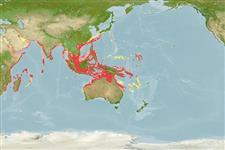>
Eupercaria/misc (Various families in series Eupercaria) >
Nemipteridae (Threadfin breams, Whiptail breams)
Etymology: Nemipterus: Greek, nema, -atos = filament + Greek, pteron = wing, fin (Ref. 45335).
Eponymy: François Péron (1775–1810) was a French voyager and naturalist. [...] (Ref. 128868), visit book page.
More on author: Valenciennes.
Environment: milieu / climate zone / depth range / distribution range
Ecología
marino; salobre demersal; no migratorio; rango de profundidad 17 - 100 m (Ref. 9785). Tropical; 34°N - 27°S, 31°E - 172°E (Ref. 3810)
Indo-West Pacific: from the Red Sea to Taiwan and northern Australia. This species name has been misapplied to Nemipterus furcosus.
Length at first maturity / Tamaño / Peso / Age
Maturity: Lm 45.0 range ? - ? cm
Max length : 29.0 cm SL macho / no sexado; (Ref. 48635); common length : 17.0 cm SL macho / no sexado; (Ref. 3810)
Espinas dorsales (total) : 10; Radios blandos dorsales (total) : 9; Espinas anales: 3; Radios blandos anales: 7. Suborbital spine absent. Preopercle with 3 transverse scale rows. Pectoral fins short, not reaching to level of anus. Pelvic fins moderately long, reaching to level of anus. Dorsal fin spines elongate, interspinous membrane deeply incised. Upper lobe of caudal fin pointed and slightly longer than lower. A line drawn up from the posterior edge of suborbital reaching the dorsal profile at or just before origin of dorsal fin. Axillary scale present. Color: Upper part of body pinkish, lower part silvery. Golden-yellow stripe on snout in front of eye.
Occurs on sand or mud bottoms and feeds on fish, crustaceans, mollusks and polychaetes. Usually in small groups; flighty during the day (Ref. 48635). Trawled in commercial quantities in the Straits of Malacca and off the Terengganu coast, South China Sea.
Life cycle and mating behavior
Madurez | Reproducción | Puesta | Huevos | Fecundidad | Larva
Two prolonged spawning seasons are likely in the South China Sea off the Trengganu coast: from November to February, and another starting in May or June. Also Ref. 103751.
Russell, B.C., 1990. FAO Species Catalogue. Vol. 12. Nemipterid fishes of the world. (Threadfin breams, whiptail breams, monocle breams, dwarf monocle breams, and coral breams). Family Nemipteridae. An annotated and illustrated catalogue of nemipterid species known to date. FAO Fish. Synop. 125(12):149p. Rome: FAO. (Ref. 3810)
IUCN Red List Status (Ref. 130435: Version 2024-2)
Threat to humans
Harmless
Human uses
Pesquerías: comercial
Herramientas
Special reports
Download XML
Fuentes de Internet
Estimates based on models
Preferred temperature (Ref.
123201): 24.1 - 28.6, mean 27.5 °C (based on 746 cells).
Phylogenetic diversity index (Ref.
82804): PD
50 = 0.5000 [Uniqueness, from 0.5 = low to 2.0 = high].
Bayesian length-weight: a=0.01288 (0.01051 - 0.01579), b=2.95 (2.91 - 2.99), in cm total length, based on LWR estimates for this species (Ref.
93245).
Nivel trófico (Ref.
69278): 3.7 ±0.3 se; based on diet studies.
Resiliencia (Ref.
120179): Alto, población duplicada en un tiempo mínimo inferior a 15 meses (tm=1).
Fishing Vulnerability (Ref.
59153): Low to moderate vulnerability (26 of 100).
